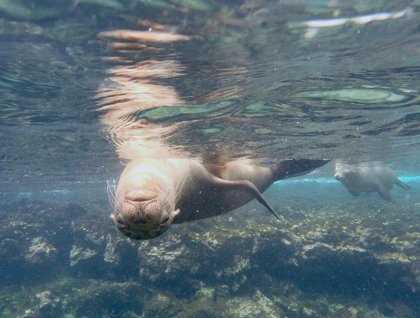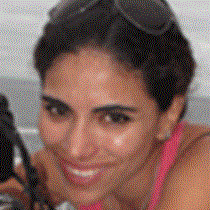We began our exploration of Punta Cormorant with several options based on our desired level activity. Some members of our group began with a long and fast paced hike; others looking to expand their photographic skills went a slower hike with our photo instructor. Still, others brought their sketch pads for hands-on sketching with Carlyn. For those who did not wish to rise quite as early, stretching classes were offered at 7am.
During the early morning hike, hikers learned about the colorful history of Floreana. For instance, stories include the abandonment of an Irish whaler because he was imbibing too many beverages, and a riveting tale regarding a “baroness.” Floreana is home to only 160 permanent residents many of whom are related to one of our Lindblad naturalists. Due to the dry season, the trees were barren of leaves which lead to a stark- looking environment, but in the wet season our view would be a lush green oasis. Our hike continued along easy walking paths (much easier than yesterday’s arduous hike) where we saw evidence of nests left by green sea turtles. At a distance, we saw flamingos that derive their pink tints from the crustaceans they eat, which in turn get their coloration from the shrimp that they eat. Blue-footed boobies dove around us as they sought out their morning meal.
After a filling breakfast of local fruits and another delicious meal prepared by the talented crew, we explored Champion Islet by Zodiac in search of the Floreana mockingbird. Interestingly, Floreana mockingbirds are no longer present on the island due to invasive predators such as rats and cats. In order to conserve the remaining species on Champion Islet, only scientists are permitted to visit. As we circled the islet, we saw firsthand how the distinctive flows of lava created the natural landscape that currently provides nesting sites for the variety of birds that reside here. We spotted brown noddy birds, Nazca boobies, swallow-tailed gull’s chicks, frigates, and a lone blue-footed booby perched on top of the islet. The prickly pears growing in the cliff provided an amazing view. The rest of the morning was spent enjoying the underwater ecosystem either from the glass bottom boat or by snorkeling. We saw a variety of krill, King Angel fish, parrot fish, sea urchins, surgeon fish, and black-striped Salema. The guests who snorkeled had the opportunity to swim among the various varieties of fish mentioned above. In addition, sea lions displayed their playful underwater acrobatics for the guests.
After lunch, we embarked on our afternoon adventure to visit the Pacific’s oldest postal system, Post Office Bay, which was a barrel set up for postal delivery by British whalers. However, this postal system is like no other because no postage is placed on the letters. In fact, whalers would take the mail from their local area and hand deliver them to the intended recipients. Imagine how the recipients must have felt receiving a post card from the Galapagos years after it had been written. Today we replicated this tradition.
During our Zodiac adventure, we spotted sea lions, Green Pacific sea turtles, lava herons, blue-footed boobies, and a few of the zodiacs spotted Galapagos penguins! One of the saddest sites of the day was seen along the coast of Loberia (“Sea Lion” Colony) where we saw a mother sea lion along the shore, who recently miscarried her pup. The kayakers saw the animals mentioned above and were delighted by the rays that followed them as they kayaked and greeted them at Postal Office Bay. The rays were searching for tidbits of food that are carried onshore by tidal action. One kayak even saw black-tipped shark.
Today was just another great example of the true character of the Galapagos. Because the Floreana islands were officially named a National Park on July 4, 1959, we are able to appreciate the natural beauty of the Galapagos Islands. As we circled Floreana Island we felt like we were part of a lovely post card! Tomorrow will not disappoint as we make our way to Santa Cruz Island to learn more about these conservation efforts.









